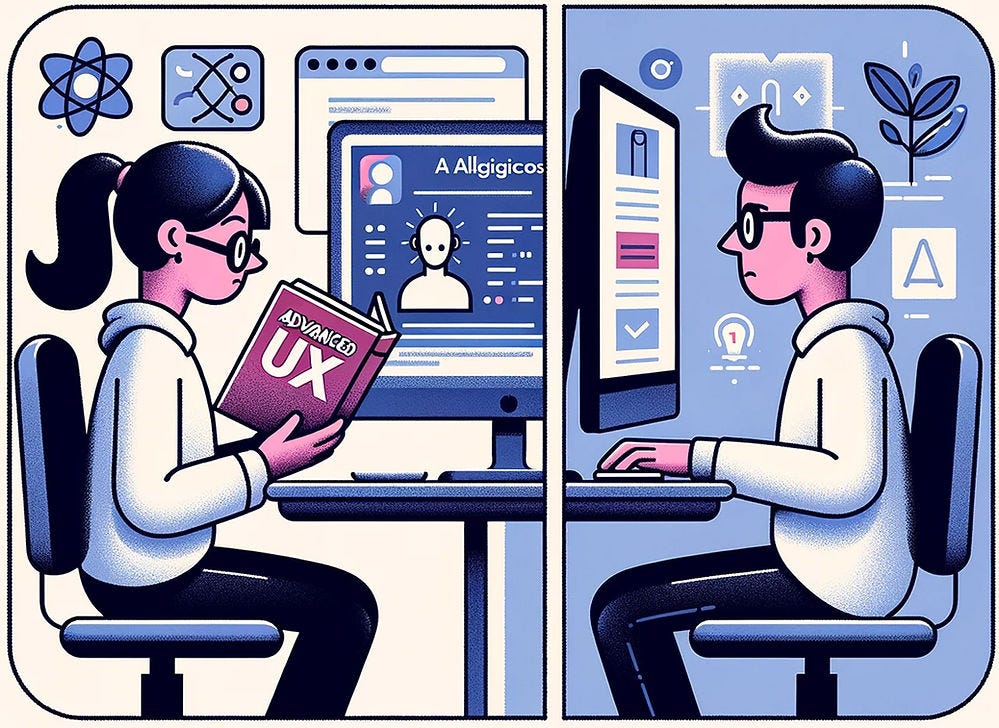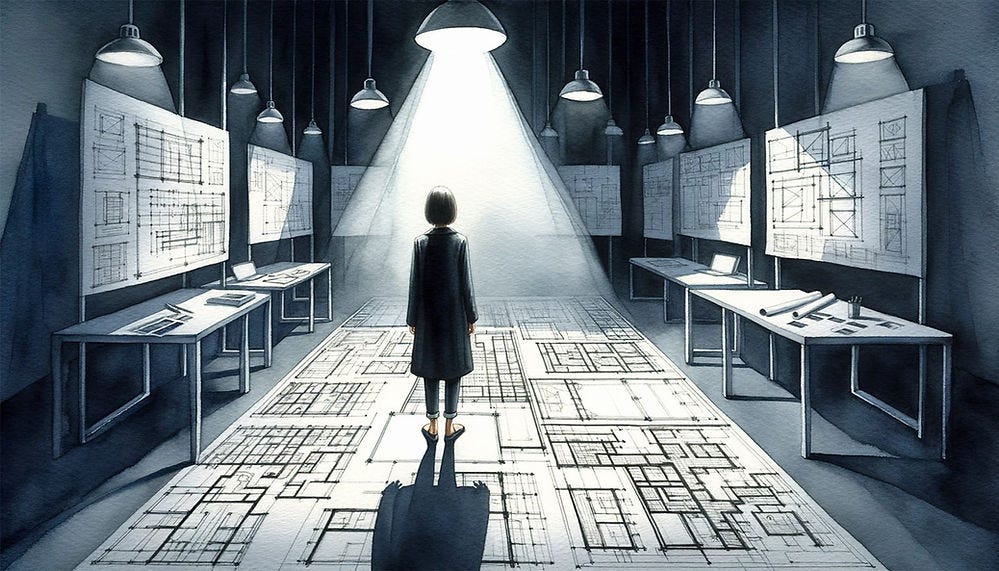Summary: Strategy for a UX professional to gain skills and professional acumen despite being the only UX specialist in a company: independent study, professional reflection, guerilla usability, interns, and portfolio maintenance since a new job will be required. Don’t be raised by wolves.
I recently mentored a young UX professional with the following story: She is very smart and received a BFA from one of the world’s most prestigious design schools a few years ago. Immediately after graduating, one of the world’s most prestigious companies hired her as a UX designer. She still has that job, pulling down a handsome salary.
Most readers would probably give a lot for this scenario to describe them. I would even do so myself, though more for being young again since I already have had plenty of prestigious, well-paying jobs.
Sadly, this rose has a thorn: my mentee is a solo UX professional. She has nobody to learn from for professional growth. Furthermore, she’s designing a very nerdy product that’s totally different from the designs most UX professionals work on. Thus, most of what she learns from her efforts doesn’t build experience that will make her better at other jobs, designing more mainstream products.
Being all alone may feel lonely. Worse, being the sole UX professional in a company or team is detrimental to your UX career when you have no colleagues to learn from. (“On your own” by Dall-E.)
In summary, this young talent’s UX career was off to a roaring start, but her long-term prospects are dim since she’s stuck in a dead-end job. The obvious advice is to get a new job, but the UX job market is currently weak. I’m convinced UX jobs will be plentiful again in a year or two, but that’s little comfort now. Also, if my mentee doesn’t change now, her prospects of landing a great job in two years will be much reduced because of the limited professional growth in her current job.
Don’t Go Back to School
I advised my mentee to do 6 things while waiting for the job market to improve. They are discussed below. But first, let’s consider an alternative I warned against: quitting her job and getting a master’s degree in UX.
Somebody with a decent UX job will be much better off spending the next two years learning on the job than ensconced in the sterile greenhouse of academia. Even if the job isn’t perfect, you learn the most from completing real UX projects as opposed to simulated ones in class. There’s also the obvious economic aspect that you get paid for those two years working, whereas you have to pay tuition for spending two years studying.
All the 6 steps I recommend in the following require extra time and effort from the young UX professional. It’s easy to say, “Why should I spend more hours for free besides cranking out those designs the company pays me to produce?” But compare extra effort on the job with going back to school: then you’ll spend two full years of unpaid efforts in the hope of upskilling. It’s much better to invest a few hundred hours of unpaid extra effort on upskilling yourself while on the job. Think of it as an investment in your next job, not as a free donation of unpaid hours to your current employer, who probably doesn’t care about your acquisition of skills that will help you get another job.
1. Study
You can study even if you’re not in a formal education program. Spend time reading in-depth UX information on the Internet. Attend meetups or professional events in your community. I list this as a separate recommended step because it’s easy to revert to only reading information needed for your current job assignment. On the contrary, force yourself to read broadly and consider it your self-curated syllabus. This requires conscious effort, so you must commit to it as one of the 6 steps to professional growth.
Your workplace becomes your classroom with the right attitude. Learn from daily practice, following the next steps in my plan.
2. Professional Reflection
The most important idea is to be your own sparring partner: after each project, spend extra time reflecting on what went well and what went poorly. Conduct your own no-holds-barred design autopsy. When you don’t have a colleague or professional UX manager to give you this feedback, put on another hat and try to be as objective and penetrating as possible in analyzing your work. Don’t just jump onto the next project; take the required time (probably over a weekend) to reflect on your just-completed project.
Study & Reflect: apply what you learn from books or other UX theory to reflect on your work products. Don’t just crank out deliverables without reflecting on them. (Image by DallE.)
3. Guerilla Usability Study
If you are a designer, you have an unparalleled ability to get independent feedback on the usability of your designs: run a simple usability study. I usually recommend testing with 5 users, but even if you only test with 3 users, you’ll get ample insights into what works with customers.
If your company doesn’t support the entire UX process with formal research, then do some guerilla research anyway. Testing 3 users will incur out-of-pocket costs of about $600, and hopefully, you can get at least that money reimbursed by the company. But if they won’t pay, consider coughing up yourself. Let’s say you run 5 such small studies per year: that’s $3,000, which is much less than university tuition.
Some purists will now say that it’s not best practice to have designers test their own designs because they can’t be objective when analyzing observations about their own creations. This is true, but absolute objectivity isn’t needed to gain insights and professional growth. The beauty of testing with real users is that they are an objective outside source of truth about your design. If users click the wrong button, you know you designed it wrong. As long as you don’t bias your test methodology horribly, you’ll get decent findings. (Yes, a skilled UX researcher specializing in nothing but running studies will do better, but our scenario says you don’t have such a creature around.)
If you’re a researcher, you hopefully get to conduct some research as part of your regular job, so the advice to conduct even more research doesn’t apply. Instead, spend the extra time watching the recordings of your own studies with an eye to criticizing your methodology, not to find usability problems in the design you were testing. Again, this is extra work, past the effort you already put into the study to learn about the design. But learning about your methodology requires a different focus. It thus should be done in a separate viewing of the recordings after you finished the usability analysis of whatever product you were testing.
4. Get an Intern
Ideally, you would grow your UX team from just being yourself to having several senior colleagues. This is unlikely to happen since even a single senior colleague will more than double the company’s UX budget — senior staff being more expensive than junior staff.
You can still gain a (less ideal) colleague by hiring an intern. Interns are cheap and don’t require the company to commit resources past the summer. You are much more likely to gain approval for an internship budget than for hiring a senior UX pro. Find some project that an intern can realistically complete in 3 months and argue why hiring an intern is worth it, given that you are already over-committed with projects. (This is usually true for solo UXers.)
You can’t directly learn much from a student. But once you have an intern, you become the senior UX professional in that relationship and become responsible for reviewing the intern’s work and explaining how to improve it. This forces you to articulate UX insights in a way that’s a great learning opportunity for yourself. Teaching something is often the best way to learn it.
5. Go All-In with AI
One of the few benefits of being on your own is that you are not tied down by existing design processes or “the way we do things around here.” You get to define the UX workflow if you’re the sole UXer. This means that you can commit to using AI to its fullest extent every step of the way.
Full use of AI has two benefits:
AI improves the productivity of professionals by anything from 33% to 66% (with the current generation of fairly poor tools). It also improves the quality of deliverables by 40% or better and supports vastly better and faster creativity. Therefore, the more you use AI, the better your current work will be. Better work gives you more recognition (and hopefully a few bonuses) in your current job and also makes your portfolio more impressive.
More important for your future career prospects, in about two years, there will be a huge demand for UX specialists with two years’ experience in using AI. The only way to gain two years’ experience in two years is to start now, but most UX specialists work in big UX teams that are slow at changing their work practices. Thus, in the near future, you will be one of the few UX pros to be fully qualified to do UX work with AI.
See my article on getting started using AI in UX work.
As a solo UX professional, you can produce more and better deliverables by using AI. While your boss will love your increased productivity, the most important outcome of your budding AI expertise is that it positions you to no longer be lonely when demand for AI-using UX pros explodes in a few years.
6. Infuse Resume and Portfolio with Business Impact Proof
If you’re in a suboptimal job, you can always hope that things get better over the next one or two years. This has been known to happen and is one of the reasons why it’s better to stay put than to quit before you land a substantially better job.
However, realistically, things are more likely than not to remain bad, so you should plan to apply for new jobs as they become available. You must be ready to jump at opportunities. This readiness requires you to keep your resume and portfolio updated continuously. Don’t wait until the perfect job posting appears. It will be too late to do substantial work on your portfolio at that time.
In our scenario, the young talent is working on a product that will not resonate with hiring managers in other industries. This means that the standard advice for job-seekers to emphasize business impact becomes even more critical. It won't interest hiring managers if you just say what you did. You must document the business impact of your UX efforts. Even if somebody doesn’t understand your industry, they understand things like “cut time in half to achieve the task” or “doubled the conversion rate.”
Raised by Wolves: A Bad Career Strategy
Leave aside the specifics of my mentee’s job situation. She is better off than most. I’ll end with general advice for any young UX professional who finds himself or herself either having a job or considering a job offer as the only UX person in a company. Don’t do it. Or at least don’t do it if you have any decent job alternatives. (If the choice is between a lousy job and starvation, you take the job.)
During at least the first 5 years (and possibly even the first 10 years) of your career, a UX professional is strongly advised to work as part of a UX team with colleagues who are senior UX professionals. It is also essential to report to a manager who is a dedicated UX manager, as opposed to somebody from a different discipline who happens to manage one or two UX people on the side.
The reason is that during those critical formative years, you learn the most from your colleagues and manager. Formal education and continuing education courses can teach a lot, but UX depends critically on the details and the correct interpretation of general rules and heuristics for specific circumstances.
On your own, you can fall back on theory from university or bootcamp. Still, you won’t get skilled at the all-important tradeoff analyses or the nuanced way of applying general usability insights to your specific customers’ needs. There’s never enough budget or time to do everything that would be nice to do, so how do you distinguish between nice-to-have and need-to-have? By experience! Or by discussing the problem with colleagues and managers who have that experience and can talk you through the decision process.
Similar for work products: How to become a better designer? By discussing your designs with senior designers and by seeing their solutions. How to become a better researcher? By discussing your research plans with senior researchers, seeing their plans, and discussing the observations you all get from your studies.
If you don’t have senior UX colleagues and don’t report to a dedicated professional UX manager for the first 5-10 years of your career, you are being raised by wolves. That story never turns out well:
In Roman myth from antiquity, Romulus and Remus were raised by wolves. Romulus went on to found the city of Rome, but he also murdered his twin brother. The moral of this story is that you may pick up some bad habits from wolves. (Romulus and Remus by Dall-E)
Once you have at least 5 years of professional UX experience under your belt from working in professional UX teams, by all means, consider joining a startup as a solo UXer. Or join an established company that’s finally starting with UX and hires you as the seed for a new program. Maybe you’re even promised a budget to hire more UX people the following year. All very nice, and you get more influence and autonomy from being the UX Czar in your company at a relatively tender age than you would get in a bigger and more mature UX organization where you have to earn your way up the promotion ladder one step at a time.
The problem with going solo too early is that you are setting yourself up for failure. I may refer to the sole UX professional in a company as the “UX Czar,” but in reality, design is not an imperial autocracy where the UX person decides what should be designed and implemented. In a company with low UX maturity, everybody else will want a finger in the pie and may easily reduce your authority to decide on the color scheme. And even that will be heavily debated.
Don’t be raised by wolves. Be raised by UX professionals. Once you’re strong and have experience, you will have the background to decide between going solo and remaining on a team where you gradually build your status. And if you do decide to go solo, you will have the professional chops to succeed. Solo too early, and you’ll fail.
Feel free to copy or use this infographic, provided you reference this URL as the source.









Oh, if only I had read the Raised by Wolf section when starting out 20 years ago. In hindsight, my learning curve during the first 10 years as a digital designer at a small advertising (and very much not digital) agency was terrible.
I did almost everything on the list (not so much AI for obvious reasons) to improve my skills but one main problem with self-learning is the lack of feedback. It's hard to ask questions about a subject, being corrected, or being challenged. Several times I discovered that I misinterpreted an idea or a method.
Years later I joined a digital agency with many smart people, with many different angles on how to solve a problem which improved my skills significantly.
Any advice for someone who found UX later in their career (around 28 yo) and went solo for the first 6 or so years (startups) based on the “credibility” of 1) age; 2) previous work experience in graphic design?
By the time I joined orgs with UX teams I was considered senior (eventually super senior) because of the same reasons mentioned above, combined with some success stories at the startups. But my imposter syndrome is quite vocal: “You didn’t learn it the right way, how can you coach younger designers?!”